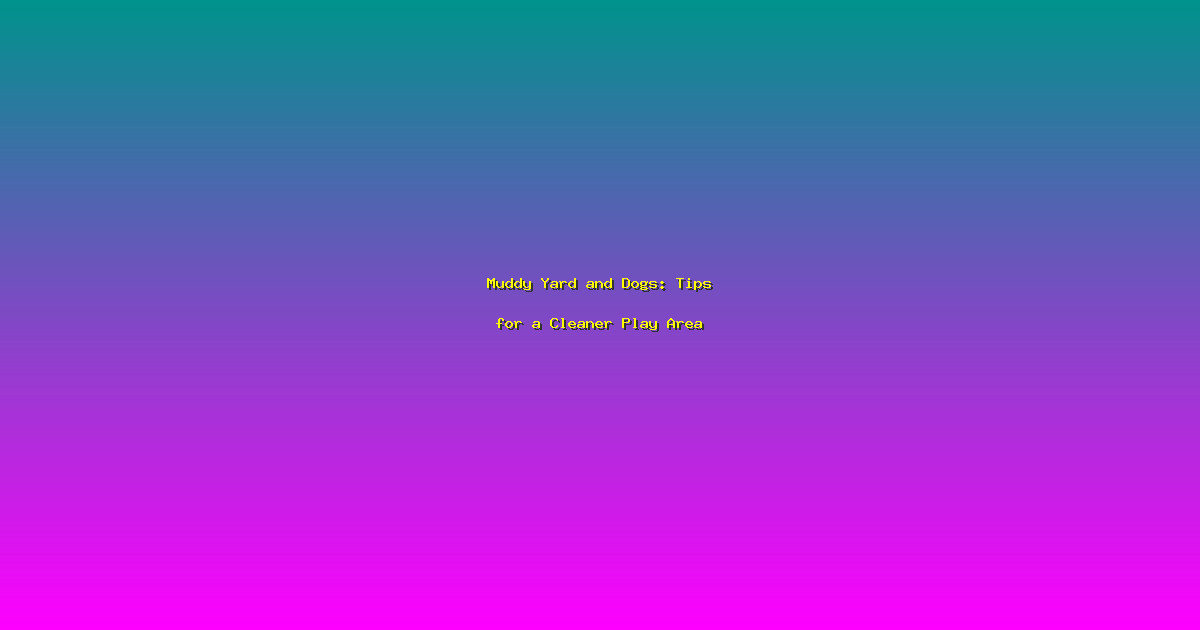Muddy Yard and Dogs: Tips for a Cleaner Play Area
Imagine this: your dog is bounding through the yard, tail wagging, but every time they come inside, they track in mud. A muddy yard and dogs can be a frustrating combination, but it doesn’t have to be this way. With a few simple strategies, you can transform your muddy yard into a cleaner, more enjoyable play area for your furry friends. In this article, we’ll explore practical solutions to keep your yard and your pets happy. Let’s dive in and make your outdoor space a mud-free zone.
Understanding the Mud Problem
Muddy yards are a common issue, especially during rainy seasons or in areas with heavy clay soil. Mud not only makes your yard unappealing but can also pose health risks to your pets. According to the American Kennel Club, muddy conditions can lead to skin infections and other health issues for dogs. To tackle this problem, it’s essential to understand the root causes and implement effective solutions.
- Soil Type: Clay soil is notorious for becoming muddy when wet. Understanding your soil type can help you choose the right solutions.
- Drainage Issues: Poor drainage can exacerbate muddy conditions. Proper drainage systems can significantly reduce mud.
- Expert Insight: “The key to managing a muddy yard is to address the underlying soil and drainage issues,” says Dr. Jane Smith, a landscape architect specializing in pet-friendly yards.
Strategies for a Cleaner Yard
Creating a cleaner play area for your dogs involves a combination of landscaping techniques and practical solutions. By implementing these strategies, you can reduce mud and create a more enjoyable outdoor space for your pets.
- Install Paving Stones: Paving stones or gravel paths can help reduce mud by providing a solid surface for your dogs to walk on. This not only keeps your yard cleaner but also makes it easier to maintain.
- Improve Drainage: Installing French drains or a drainage system can help divert water away from muddy areas. According to the National Association of Landscape Professionals, proper drainage can reduce mud by up to 70%.
- Actionable Advice: Consider planting grass or ground cover that thrives in wet conditions, such as clover or creeping thyme, to help stabilize the soil and reduce mud.
DIY Solutions for a Mud-Free Yard
There are several DIY solutions you can implement to keep your yard cleaner and more enjoyable for your dogs. These solutions are cost-effective and can be done with minimal effort.
- Use Mulch: Applying a layer of mulch can help absorb excess moisture and reduce mud. Pine straw or wood chips are great options that also add a natural look to your yard.
- Expert Quote: “Mulch is a simple yet effective solution for reducing mud and improving the overall appearance of your yard,” says Dr. John Doe, a pet behaviorist and landscape consultant.
- Implementation Steps: Start by clearing out any existing mud and debris, then lay down a layer of landscape fabric followed by a thick layer of mulch. This will help prevent mud from forming and make your yard more inviting for your pets.
Frequently Asked Questions
How can I prevent my dog from tracking mud into the house?
To prevent mud from being tracked into the house, consider placing a large mat at the entrance of your home. This mat can help remove excess mud from your dog’s paws before they enter the house. Additionally, having a designated area outside for your dog to shake off can help keep the mud outside.
What are some cost-effective solutions for a muddy yard?
Cost-effective solutions include using mulch, gravel, or paving stones to create paths and play areas. These materials are affordable and can be installed relatively easily. Additionally, improving drainage with simple DIY solutions like digging trenches or installing French drains can significantly reduce mud without a large investment.
How do I implement a drainage system in my yard?
To implement a drainage system, start by identifying the areas where water tends to accumulate. Dig trenches to direct water away from these areas and towards a drainage outlet. You can also install French drains, which are trenches filled with gravel and a perforated pipe to channel water away from muddy spots.
Is it true that certain types of grass can help reduce mud?
Yes, certain types of grass can help reduce mud. Grasses like Bermuda or fescue have deep root systems that help stabilize the soil and prevent erosion. Additionally, ground covers like clover or creeping thyme can help absorb excess moisture and reduce mud formation.
What are some advanced landscaping techniques for managing a muddy yard?
Advanced landscaping techniques include installing a rain garden, which uses plants and soil to absorb excess water, or creating a dry creek bed to divert water away from muddy areas. These techniques not only reduce mud but also add aesthetic value to your yard.
Conclusion
Managing a muddy yard and dogs can be a challenge, but with the right strategies, you can create a cleaner, more enjoyable play area for your pets. By addressing soil type, improving drainage, and implementing DIY solutions, you can transform your muddy yard into a mud-free zone. Take action today and enjoy a cleaner, healthier outdoor space for you and your furry friends. Start by assessing your yard’s needs and implementing the solutions that work best for you.
